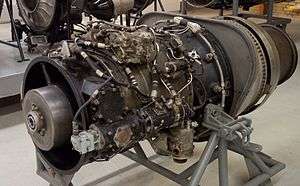Armstrong Siddeley Viper
| Viper | |
|---|---|
 | |
| Preserved Rolls-Royce Viper Turbojet | |
| Type | Turbojet |
| Manufacturer | Armstrong Siddeley Rolls-Royce Limited |
| First run | April 1951 |
| Major applications | BAC Jet Provost HS Dominie Aermacchi MB-326 |
| Developed from | Armstrong Siddeley Adder |
The Armstrong Siddeley Viper is a British turbojet engine developed and produced by Armstrong Siddeley and then by its successor companies Bristol Siddeley and Rolls-Royce Limited. It entered service in 1953 and remained in use with the Royal Air Force, powering its Dominie T1 navigation training aircraft until January 2011.[1]
Design and development
The design originally featured a seven-stage compressor based on their Adder engine — the Viper is in effect a large-scale Adder.
Like the similar J85 built in United States, the Viper was developed as an expendable engine for powering production versions of the Jindivik target drone,[2] but, again like the J85, the limited-life components and total-loss oil systems were replaced with standard systems for use in manned aircraft.
Because it was initially developed as an expendable engine, the Viper was subject to many recurring maintenance issues. This led to the development of the first Power by the Hour program in which operators would pay a fixed hourly rate to Bristol Siddeley for the continual maintenance of the engines.[3]
Variants

Data from Jane's All the World's Aircraft 1962-63.[4]
- ASV.3
- Short life for missile/target applications, 1,640 lbf (7.30 kN).[5]
- ASV.4
- Short life for missile/target applications, 1,750 lbf (7.78 kN).[5]
- ASV.5
- Extended life version for manned aircraft.[5]
- ASV.6
- Short life for missile/target applications, 1,900 lbf (8.45 kN).[5]
- ASV.7
- [5]
- ASV.7/R
- 2,470 lbf (10.99 kN) with re-heat.[5]
- ASV.10
- [5]
- Viper 8
- (Mk.102 / Mk.104): Engines for the Hunting-Percival Jet Provost TMk.3 (Mk.102) and GAF Jindivik Mk.102B target drone (Mk.104).
- Viper 9
- (Mk.103): Powered the Bell X-14 and Handley Page HP 115 among others.
- Viper 11
- (Mk.200): Powered the Hunting-Percival Jet Provost TMk.4(Mk202) and GAF Jindivik Mk.3 among others.
- Viper 20
- (Mk.500 series): Powered the Hawker Siddeley HS.125 and Piaggio-Douglas PD.808 among others.
- Viper 22
- Built under licence by Piaggio for the Aermacchi MB.326
- Mk.102
- Mk.103
- Mk.104
- Mk.200
- Mk.201
- Mk.202
- Mk.204
Evidence found on a surviving Mk204 engine suggests this is a Mk202 variant with increased temperature and oil pressure transmission capabilities. These are thought to be safety measures installed for use in Jet Provost aircraft used by HRH Prince Charles during his Royal Air Force flight training programme.
- Mk.301
- Mk.500 series
- Mk.520
- Mk.601
- M.D.30 Viper
- Engines licence-built and developedby Dassault Aviation[5]
Engines on display
Preserved Viper engines are on public display at the following museums:
- Aerospace Museum of California
- AeroVenture (South Yorkshire Aircraft Museum)
- Caernarfon Airworld Aviation Museum
- Midland Air Museum
- Newark Air Museum
- Rolls-Royce Heritage Trust Allison Branch Museum Indianapolis
- Royal Air Force Museum Cosford
- UniKl MIAT, Jenderam Hulu Sepang Malaysia
- Solent Sky
- South African Air Force Museum
- Wings of a Dream Museum (TAM Airlines Museum)
- Rolls-Royce Heritage Trust, James A. Allison Exhibition Indianapolis
- Former RAF Metheringham, a Mk204 engine is installed and operated in Jet Provost Mk4, XS186
- Queensland Air Museum, Caloundra, Australia
Applications
- Aermacchi MB-339
- Aermacchi MB-326
- Atlas Aircraft Impala
- Avro Shackleton
- BAC Jet Provost
- BAC Strikemaster
- Bell X-14
- Blue Origin Charon
- Dassault M.D.550 Mystere-Delta
- Embraer AT-26 Xavante
- Folland Midge
- GAF Jindivik
- Hawker Siddeley Dominie
- Handley Page HP.115
- IAR 99
- Piaggio PD.808
- Saunders-Roe SR.53
- Soko J-22 Orao/IAR-93 Vultur
- Soko G-2 Galeb
- Soko G-4 Super Galeb
Specifications (Viper ASV.12)
Data from [6]
General characteristics
- Type: Turbojet
- Length: 64.0 in (1,625 mm)
- Diameter: 24.55 in (624 mm)
- Dry weight: 549 lb (249 kg)
Components
- Compressor: Seven stage axial
- Combustors: Annular, 24 burners
- Turbine: Single stage
- Fuel type: AVTUR, AVTAG
- Oil system: scavenge, metered
Performance
- Maximum thrust: 2,700 lb (12 kN) at 13,800 rpm
- Overall pressure ratio: 4.3:1
- Air mass flow: 44 lb/sec (20 kg/s)
- Specific fuel consumption: 1.09 lb/hr/lb
oil consumption=1.25 pints/hr (0.7l/h)
- Thrust-to-weight ratio: 4.9:1
See also
- Related development
- Comparable engines
- Related lists
References
Notes
- ↑ Dominie T1 www.raf.mod.uk. Retrieved: 14 October 2009
- ↑ Gunston 1989, p.20.
- ↑ "Selling the DH125". Flight Global.
- ↑ Taylor, John W.R. FRHistS. ARAeS (1962). Jane's All the World's Aircraft 1962-63. London: Sampson, Low, Marston & Co Ltd.
- 1 2 3 4 5 6 7 8 Taylor, John W.R. FRHistS. ARAeS (1955). Jane's All the World's Aircraft 1955-56. London: Sampson, Low, Marston & Co Ltd.
- ↑ Flight Global Archive - 1955 Retrieved: 3 November 2008
Bibliography
- Taylor, John W.R. FRHistS. ARAeS (1962). Jane's All the World's Aircraft 1962-63. London: Sampson, Low, Marston & Co Ltd.
- Gunston, Bill. World Encyclopedia of Aero Engines. Cambridge, England. Patrick Stephens Limited, 1989. ISBN 1-85260-163-9
External links
| Wikimedia Commons has media related to Bristol Siddeley Viper. |